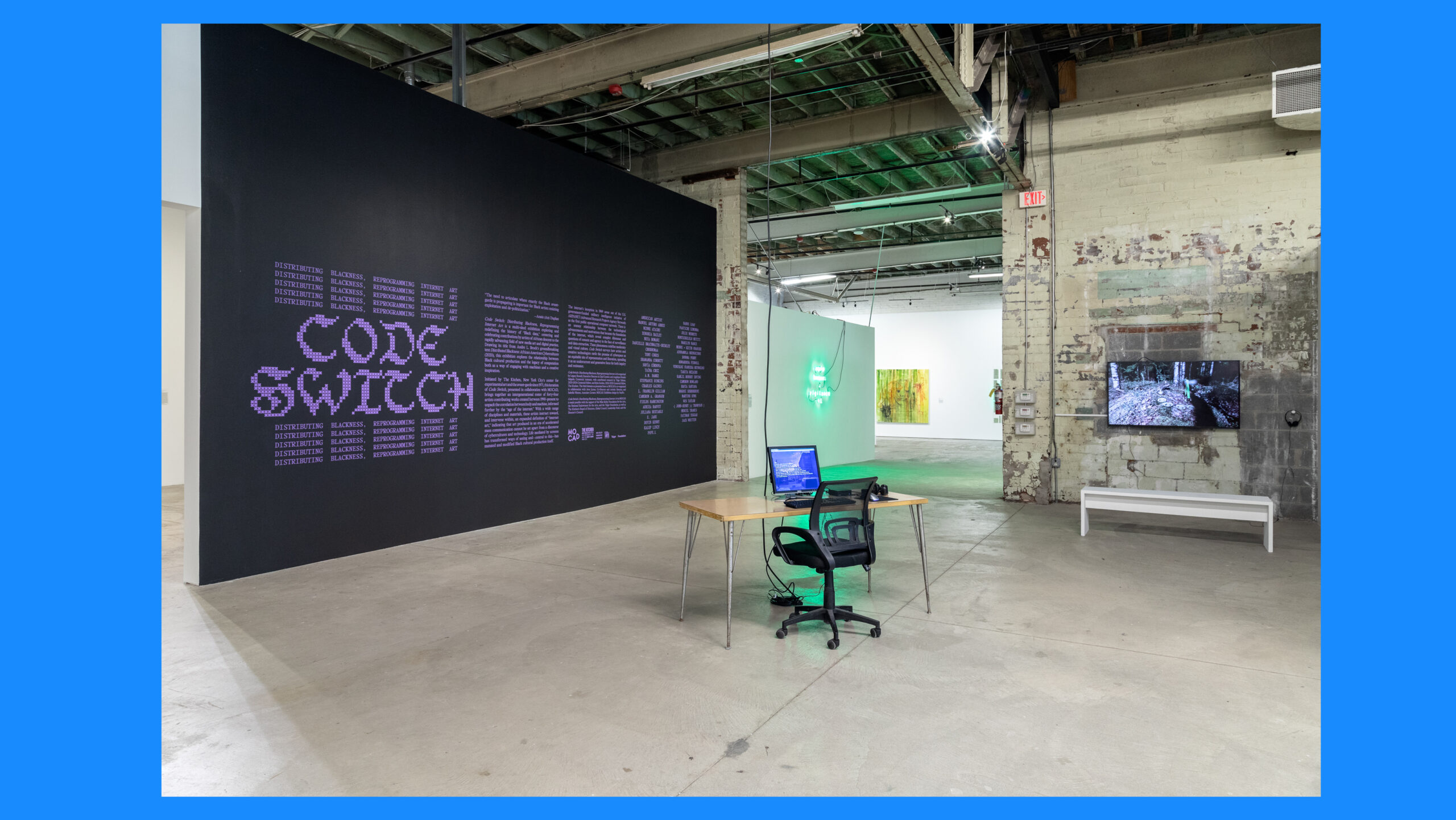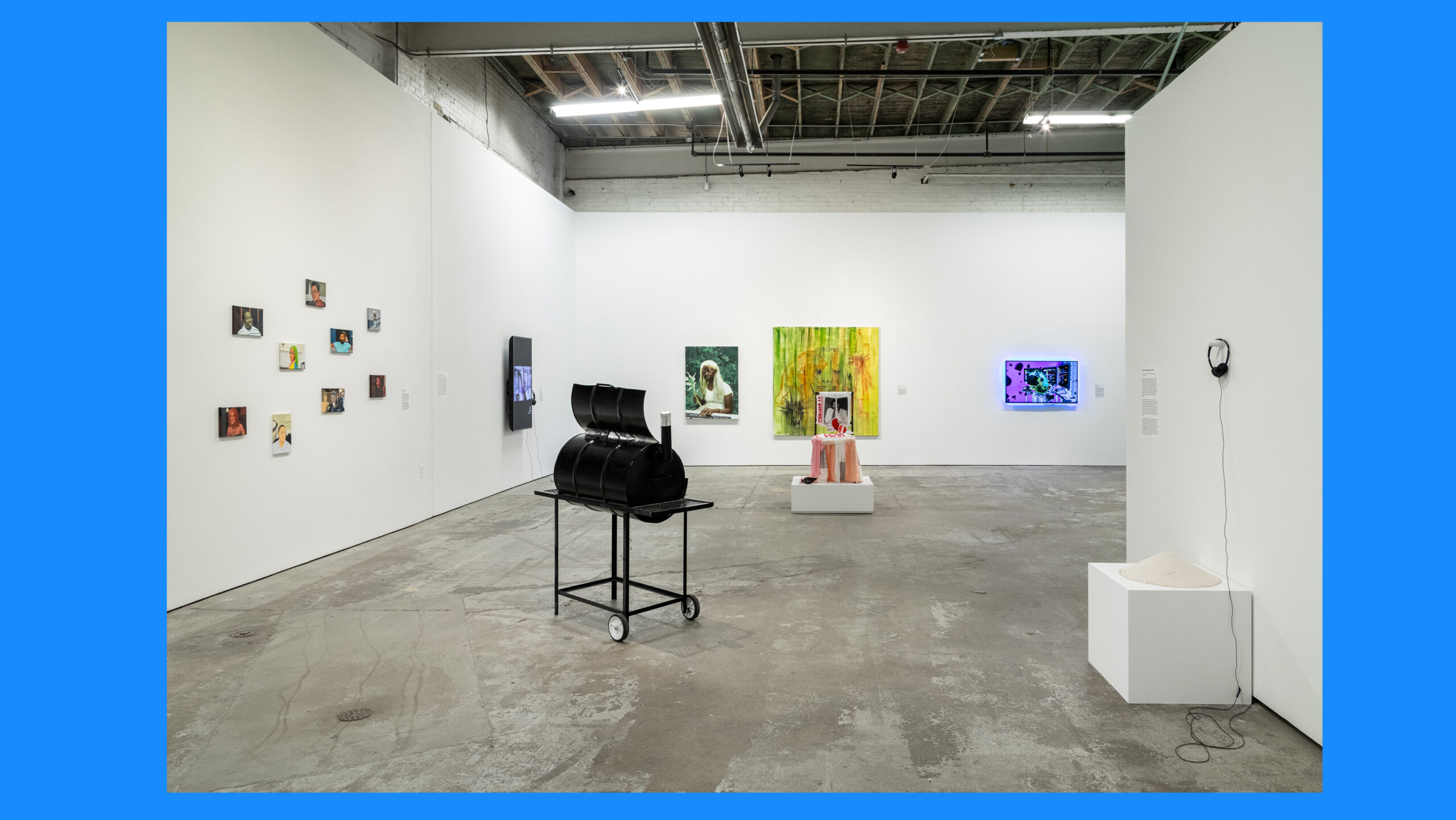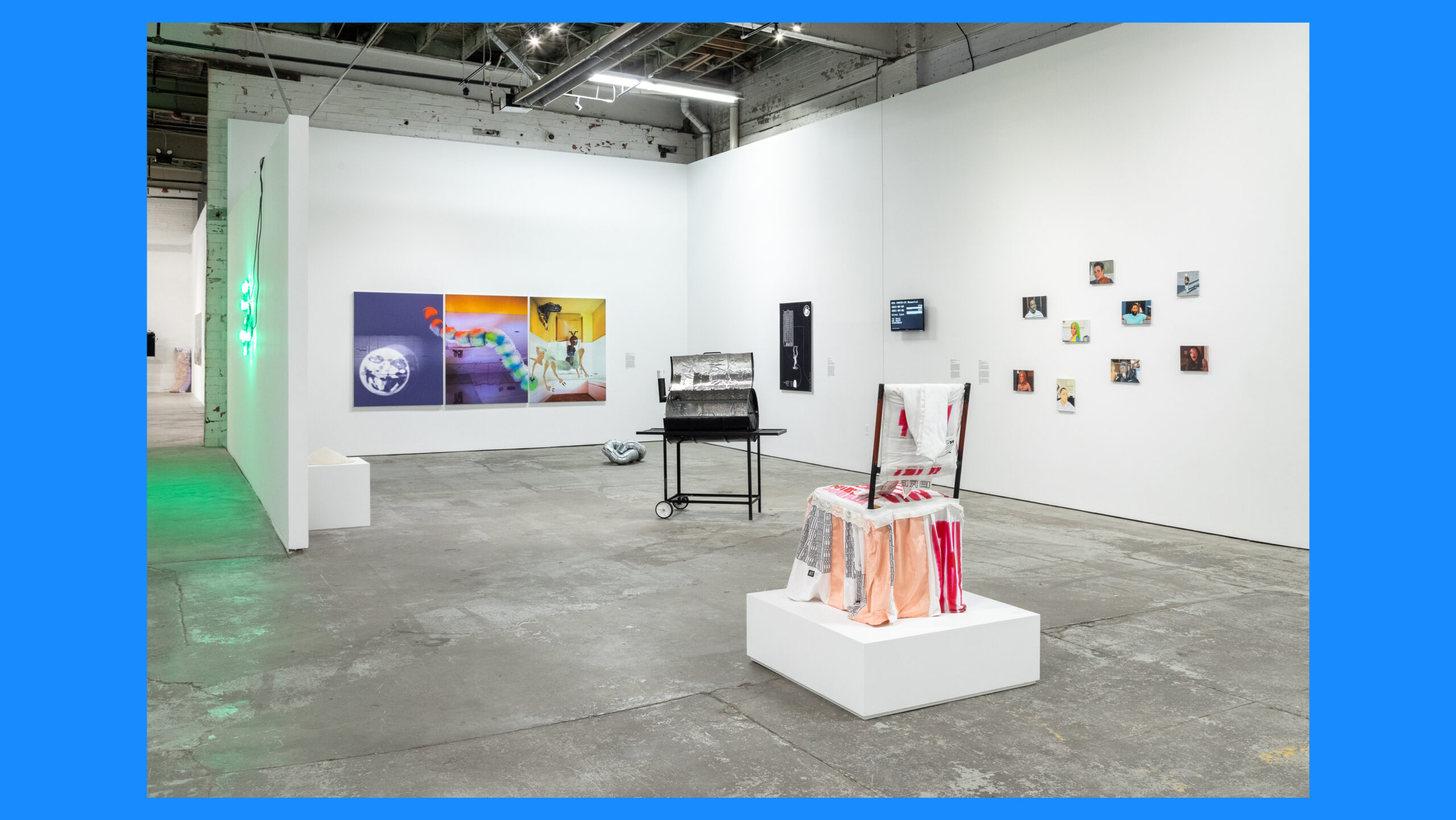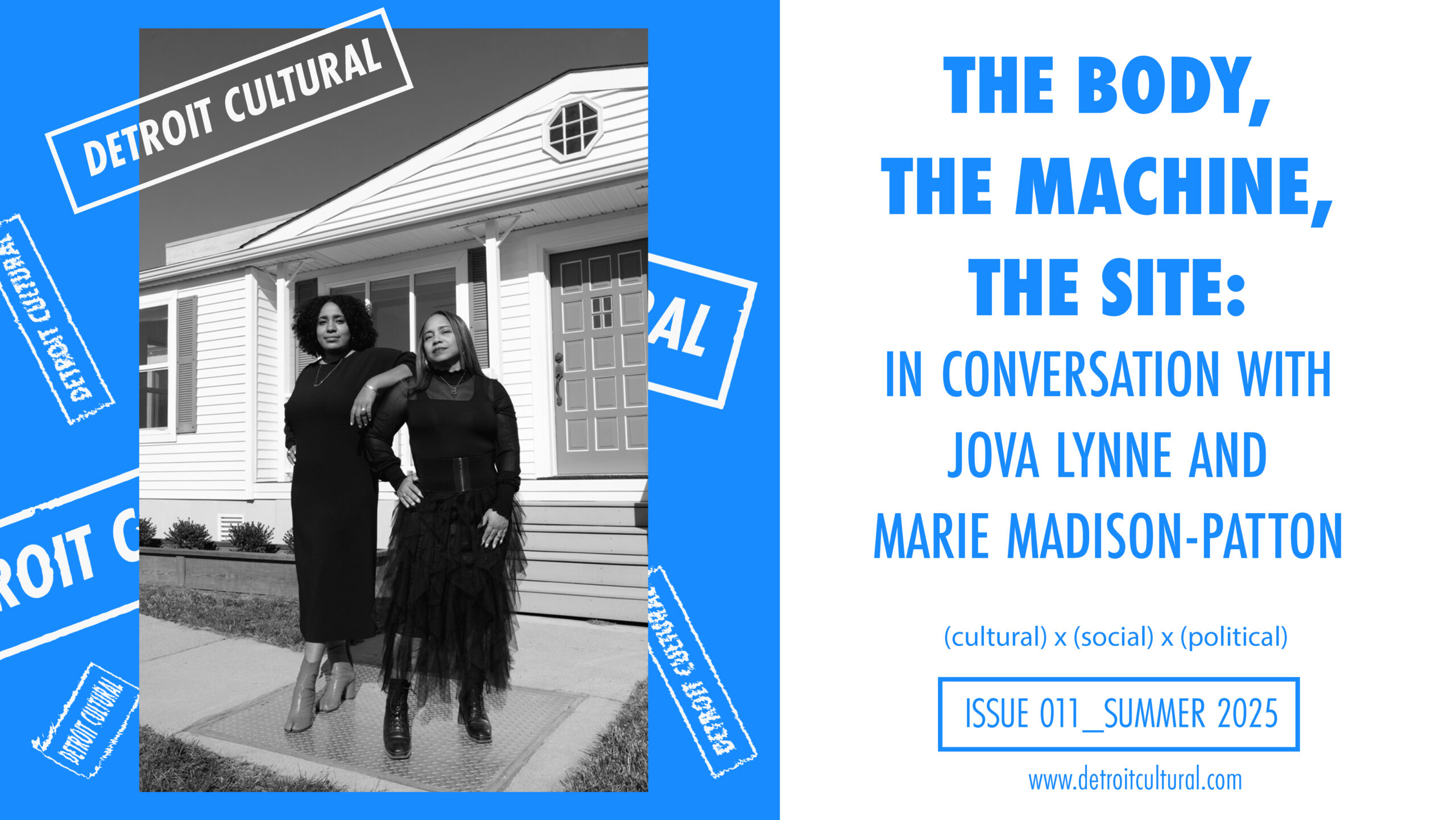Jova Lynne and Marie Ann Madison-Patton are the Co-Directors of the Museum of Contemporary Art Detroit (MOCAD). Lynne first joined the institution in 2017 as a Ford Foundation Curatorial Fellow and in 2019 became the Susanne Feld Hilberry Senior Curator. Prior to MOCAD, Lynne was Director at Temple Contemporary at Philadelphia’s Tyler School of Contemporary Art and Architecture. Lynne worked in the education departments of the Museum of Moving Image in Queens, New York and the Yerba Buena Center for the Arts in San Francisco. Marie Ann Madison-Patton brings nearly two decades of extensive experience in museum management to her role, serving as the Finance Director and Deputy Director at MOCAD for twelve years and in the finance department at the Charles H. Wright Museum of African American History for six years. She serves on the board of Midtown Detroit, Inc.
We sat down with them to discuss MOCAD’s two summer exhibitions, “Code Switch: Distributing Blackness, Reprogramming Internet Art”, and “The Gun Violence Memorial Project”, as well as the current state of art institutions in the United States at a moment in which federal funding for the arts is under attack.

DC: This show is the second iteration, with the first being an archival exhibition at the Schomburg Center for Research in Black Culture. Were either of you able to see that first iteration? How did this collaboration with the Kitchen come to be? How did the selection of artists and works occur?
JL: It’s the second iteration of the exhibition. I did see the show in Harlem, and it was archival, it was beautiful. It was on a much smaller scale, and the foundation of this iteration is rooted in that archival exhibition, which is what Legacy (Legacy Russell, writer and Executive Director and Chief Curator of the Kitchen) considers the first domain of Code Switch.
I’ve known Legacy for quite a while and I appreciate and respect her scholarship around issues related to Blackness, sovereignty, data, and what that means in terms of feminist and liberatory movements. Legacy was looking to figure out where the next domain of Code Switch would be and we had a conversation about it being here in Detroit. Detroit being the site of so much technological movements when we look at the history of cars, automation, and also music and the intrinsic nature in which the machine drives these forces but also the complexity of the body, and especially in a Black cultural landscape and the history that Detroit has being implicated in that.
So Legacy came with the framework of the idea and the scholarship and we worked collaboratively on artist selection. It was Legacy and Angelique from the Kitchen’s Curatorial Team, and then myself and Isabella Nimmo, who is one of MOCAD’s Associate Curators. It looked like weekly phone calls, it looked like a lot of check-ins, it looked like sharing floor plans across the internet and being like, “this is what we think can work,” based on the vision that Legacy had. It was a really beautiful cross-pollination of collaboration across our institutions.
With the show we also have a series of public programs that MOCAD has curated specifically tailored to Detroit and things that are going on locally.
DC: Could you talk about some of the public programming that is in relation to these two new exhibitions-I saw Stephanie Dinkins is doing an artist talk with Lisa Nakamura on Love and Data.
JL: And that is a talk about collaboration that is in collaboration with Stamps, University of Michigan’s Art School, so we’re really excited to have those folks apart of making that program happen. We have two local artists who are doing presentations and conversations.
One is Vanessa Reynolds, also known as Venusloc, who has a video in the exhibition. They are going to be talking about Project Green Light, and questions of surveillance and autonomy, and what it means to create signage around it, either to identify it or to alert someone that something is happening around it. We are going to be making some zines, re-imagining of what infrastructure and signage in our communities look like that highlight safety rather than surveillance.
And then Wesley Taylor, whose work Black Portals is in the front gallery—which is a constellation of various objects of materials including architectural salvaged materials, ceramics, electronics—he is doing a conversation about future speculation through the idea of a Black Portal where we’re in community with each other but also jumping through these portals and what does it mean to get to the other side. Wes is someone who works very collaboratively usually and has an artist collective named Talking Dolls based on the East side of Detroit, and so what’s happening in that work and the program is that there will be a radio frequency transmitted from the East side to MOCAD and then we will be remitting it from here to the East side.
Those are just a handful of the programs. We have a Curatorial Book Club where we’re reading Legacy Russell’s Black Meme which really does speak to a lot of the context of the show. We’ve been doing a lot of tours, we did a bunch of tours with high school kids and they had a lot to say about the show. They’re very fascinated by the meme works by Pastiche Lumumba. It’s been fun.
DC: Are there any thematic through-lines that you see between the combinations of works in the show? I noticed quite a few pieces like the multiple video game-based works that seem to share a connection of requiring audience participation. I’m curious what are some of the links you’ve seen between works that are most interesting to you at this moment?
JL: I think at its core we’re talking about the legacy of Black culture and the internet, and that means that it requires the viewer to participate. I think that’s something that’s actually really beautiful about the works, like gaming works and interactive works where you’re either functionally doing something—in the Homestead (Mike Kelley’s Homestead) there’s a call and response with an AI generator that uses ChatGPT to talk to you. Black culture and the ways in which we all as a society are connected are intrinsic to the show. I would say in terms of the interactive elements, absolutely.
There are a couple paintings, a couple abstract works, that would surprise a viewer, but I also think that abstraction is important when we talk about the way technology is not only utilized in terms of hard tools and instruments like computers or a TV monitor, but also how its intrinsic in fine art through painting and sculpture.

DC: I have a quote here from the curatorial text for the show that I was hoping you could unpack or build upon: “Code Switch surveys how artists and creative technologists rattle the promise of cyberspace as an equitable site of representation and liberation, upending it as an undercurrent and generative force for both inquiry and resistance.”
JL: I think that the internet mirrors what happens in our reality. The internet is this subversive world, and this world where everyone is free to do whatever they want, it still replicates some of the oppressive forces that we see in our world in regular, everyday life. You think about young men on the internet who are radicalized into white supremacist ideology. I’m using that radicalization as an example of the promise of equity that doesn’t exist because its mirroring human behavior that impacts larger society.
I think the promise of the internet was, “everybody can be equal here”, and, “everybody can access it,” and another layer of that is that that’s not true. Detroit used to be an internet desert, MOCAD was one of the first places that offered free WIFI in this neighborhood for anybody. So when you think about what access to knowledge means, I mentioned the radicalization, but also access to knowledge in terms of somebody learning something that they couldn’t learn in school on the internet. Somebody having a moment where they can figure out what their identity means on the internet if they live in a small town and don’t have other people who look like them or think like them. I think its two sides of the same coin.
So when we talk about the internet as mainly a technology that was created as a military tool that has now grown into this other thing, to me that quote also recognizes that because the internet mirrors society that promise of equity isn’t quite there yet. So Black artists and Black creators are moving the needle forward in terms of getting us there and getting us to think about that double-sided coin or that mirror. Technology mirrors real life and we mirror it back to.
It’s still always culturally circumscribed, and it’s only every going to reproduce the culture that produces it.
JL: Even the AI piece that I’m talking about, the AI was written through the lens of an older white man.
DC: But it presents itself as being this objective, neutral, culturally un-biased thing.
JL: Exactly, but its not. It doesn’t code switch. It doesn’t in the ways that maybe I have to, or Marie has to, or Legacy. So I think that’s the heart of the issue—these things are created with equity in mind, they’re created as a replica of sustaining white dominance in culture.
MMP: It’s a reminder of the inequalities that are there, and when you code switch it just reminds you how much isn’t for you.
DC: In this moment in which both historical museums and the arts are under attack by the federal government for not promoting “American values”—what do you see as the role of museums in a democratic society?
MMP: Part of our mission is that we create a space for diverse and creative voices to be able to coincide and have dialogue about what’s going on in our society. I think the most important thing for us is giving the opportunity to have that space and just making sure that people’s voices are heard.
JL: MOCAD is going to celebrate its 20th anniversary next year and so I’ve been doing a lot of research around the origin of the museum and what does it meant to be a museum, how did museums get started, and some of it is very beautiful and some of it is very ugly. And I think when we’re talking about democracy or talking about duality, and as Marie said, two ideas, two voices living sort of side by side with each other, and if we look at that, as a museum we are obligated to continue that conversation. We are obligated to be a space where people can gather and learn and share. Because that’s at the core of what a museum is, because that’s literally written into our mission.
MMP: I think that’s what we believe that’s what the core of a museum is, I do think there are some traditional thoughts of what a museum is as just white walls with pretty pictures, but we want to make sure that we go beyond the walls and do much more than that.
JL: So for example how we were the first place where people can come in and use the cafe and get free WIFI, you don’t even have to see the work. Something else Marie and I have been talking about as we plan for year twenty is the museum as a commons for civic engagement, as a place where people can come together and literally have dialogue. The beautiful thing about being a contemporary art museum is that we talk about what’s happening in the world in the now. Of course history is going to impact what’s happening in the now, but we aren’t beholden to one history. So I think art being able to speak beyond language barrier, beyond education level, beyond implications of race, class, community, that’s the power of art as a tool to create that community commons, and that’s what we do here as a contemporary art museum.

DC: Do you find that your position has social and political responsibilities and if so what are the most important to you?
JL: We may have two different answers.
MMP: We might.
JL: Because our work is also different.
MMP: I feel like politically we have to fall outside of that, because we are a representation of an institution that should be welcoming to all so you don’t want to alienate one side or the other. Socially, I think it goes back to the previous question in that we make sure we uphold the mission and create the space for people to be able to have that dialogue and be able to discuss social issues.
JL: “Political” is such a big word and can mean so many different things. As a museum we have to remain non-partisan, and at the same time I think we are obligated to uplifting what is happening in the now. The function of exhibitions and displaying art is to tell a story and that story often coincides with what is happening in our world, and so I do think that whatever that thing that is happening that we decide to take on is, I do think that we are obligated to speak on it, and if somebody finds it political they find it political. I think for me I approach this work as being very deeply invested in humanity and the future of humanity, and I think the museum as a site for that knowledge sharing is so important for the future of humanity.
Gun Violence Memorial Project for example, that show was funded by the NEA, that show lost its funding. It was seen as political. To me, death and violence is a non-partisan issue, it is a human reality that all of our communities face no matter what color, class, level of education, people have experienced loss, and a gun is a tool that causes harm and loss. Could it be seen as a political show? Sure. Really its about honoring lives. That’s what I mean when I say we’re going to respond to issues of humanity here.
MMP: I like what you said about the work really being in humanity, and I think we need to remember that humanity is not political, its just being human. I think it kind of gets convoluted sometimes.
